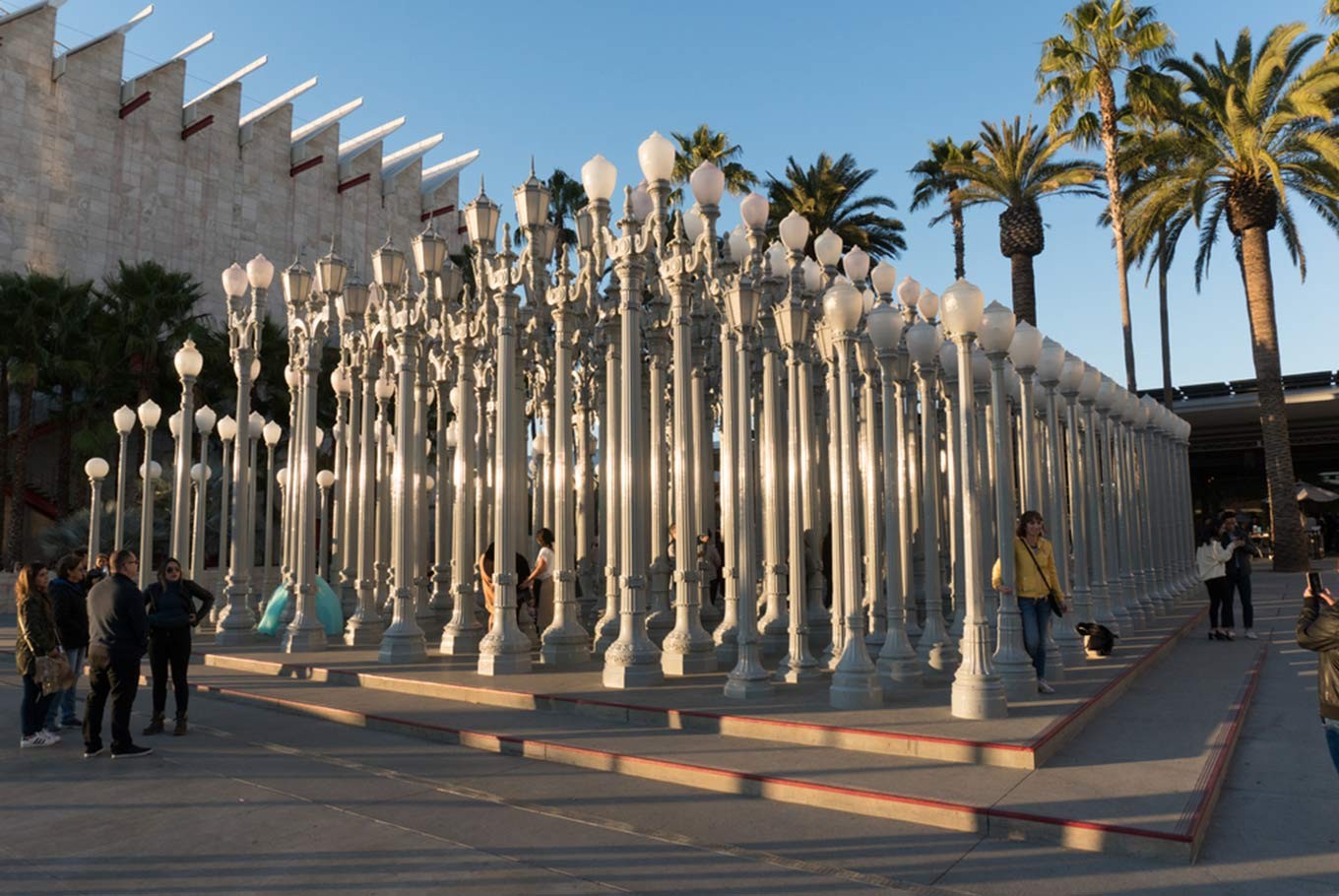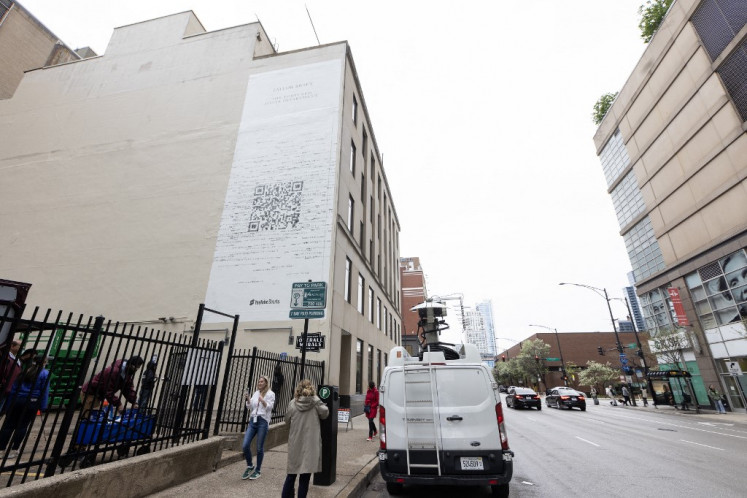Selfies: Root of all evil in Indonesian tourism
Only two months after its soft launch, Rabbit Town has caused controversy for appearing to plagiarize three iconic contemporary art installations as their “attractions”, without any recognition of the original artists whatsoever.
Change Size
 'Urban Lights' is a large-scale assemblage sculpture by Chris Burden at the Los Angeles County Museum of Art. (Shutterstock.com/Mark1260423 )
'Urban Lights' is a large-scale assemblage sculpture by Chris Burden at the Los Angeles County Museum of Art. (Shutterstock.com/Mark1260423 )
B
y now, you must have heard about the newly opened Rabbit Town in Bandung, West Java, but not for the right reasons. Only two months after its soft launch, Rabbit Town has caused controversy for appearing to plagiarize three iconic contemporary art installations as their “attractions”, without any recognition of the original artists whatsoever.
The installations are Chris Burden’s Urban Lights, Yayoi Kusama’s Obliteration Room, and parts of the Museum of Ice Cream in United States.
Chris Burden’s Urban Light at the Los Angeles County Museum of Art (LACMA) is a large-scale installation made up of 202 functioning lampposts, and Rabbit Town created a similar version named Love Light. In Yayoi Kusama’s Obliteration Room, visitors are encouraged to gradually transform an all-white room by placing colorful dot stickers all over the space, and you can do the exact same thing in Rabbit Town’s Patrico Sticker. Moreover, if you have been wanting to visit the super popular, super Instagrammable Museum of Ice Cream in United States, no fret. Rabbit Town has carbon copies of it, too!
Read also: Rabbit Town, ‘selfie culture’ versus awareness of art
Rabbit Town’s major motivation for their alleged piracy seems to simply make themselves an Instagrammable destination, rather than to evoke visitors’ awe and contemplation with contemporary artworks. In fact, they proclaim themselves as a wisata selfie (selfie tourism) destination, and they offer almost no other experience but giant photo backgrounds.
Rabbit Town is the creation of Henry Husada, the chairman and CEO of the hotel management company Kagum Group, which holds Museum Rekor Indonesia’s record in 2014 for having 15 new hotels launched at the same time. Rabbit Town was named after Henry's zodiac sign, and the property was originally his private mansion.
Ever since the news went viral, many Indonesians have been angered. Comparison photos with mocking captions swirl around the internet, and the Rabbit Town’s Instagram page was flooded with angry comments. I said “was”, because shortly after it came under attack, Rabbit Town closed its comment section and blocked anyone who mentioned LACMA, Yayoi Kusama, or the Museum of Ice Cream.
Indonesia is thriving. Not just economically, but also culturally. The middle class is growing stronger, more educated, more well-traveled, and more culturally knowledgeable than ever. However, Rabbit Town’s alleged plagiarism embarrassingly gives the impression that Indonesians are lazy, ignorant, uncultured, thus invalidating our previous endeavors.
Rabbit Town’s alleged plagiarism might have occurred because Henry is simply ignorant, but it might also be because he realizes the lucrativeness of monetizing selfies and narcissism.
Today, it seems that selfies and narcissism are the root of evil in Indonesian tourism.
Read also: People are not for sale: How Instagram normalizes objectification
Why?
First of all, tourists’ love of selfies degrades travel destinations.
The experience that the place has to offer is no longer significant, because all people care about is how photogenic or Instagrammable the place is. Today’s tourists don’t notice the wonderful fresh-smelling air in a pine forest they walk through, nor do they care about the rich history of ancient ruins they visit. Their main focus is whether the place will make their photos look aesthetically pleasing, and how many likes will they garner on social media.
A couple of years ago, I went to Copenhagen. During a relaxed afternoon stroll at Nyhavn, I came across another family from Indonesia. They looked rushed, tired, half running with their selfie sticks. We chatted a bit and I asked them about their travels. They told me that they were on a two-week whirlwind tour across Western Europe but spending only two days in each city or country.
“Isn’t that exhausting?” I asked.
The father chuckled while adjusting his selfie stick, “Nah. What’s important that we manage to get selfies in each city’s landmarks. Why waste time spending longer than that, right?”
Second, with the growing narcissism that is fueled by image-heavy social media, tourists today become caught in their own bubble—oblivious and ignorant. Therefore, along come issues such as unethical tourism and broken artwork.
Just recently Indonesian singer Syahrini was flamed because she took ignorant, very self-centered selfies at the Holocaust Memorial in Berlin. Only last year I witnessed a multi-million-rupiah sculpture in the National Gallery of Indonesia get accidentally knocked over and almost crash to pieces by teenagers who tried to take selfies in front of the artwork.
Thirdly, aesthetic photos are undeniably an effective marketing tool for the tourism site, but this isn’t always a good thing.
When stunning images go viral, they can release a horde of tourists eager to get a copycat photo. Hence, developers now focus more and more on the aesthetic aspects of their tourism site, not the experience it can give, nor the whole quality of the place. As long as the place has photogenic points here and there, it is enough. Take a look at Rabbit Town, whose main selling point is its photo backgrounds, and almost nothing else.
Read also: Rethink that selfie with wild animals, warns Instagram
Moreover, if we go to natural-tourism sites such as Mount Merapi in Central Java, Maribaya in West Java, Mangunan and Imogiri Pine Forest in Yogyakarta, we see numerous photo platforms or photo backgrounds being erected by locals, who charge visitors Rp 5,000 (less than 50 US cents) to Rp 50,000 to have their pictures taken there, usually against the breathtaking landscape.
Sometimes this photo-op “facility” overshadows or even sacrifices the real experience of the site. For instance, Kalibiru Tourism Village near Yogyakarta redesigned their zip-lines and treetop platforms into a fully fledged photo-op destination.
However, such photo destinations often become very successful. Shelly Banjo from Bloomberg reported that in Kalibiru, waiting times now stretch to six hours on popular days, prompting a nearby village to raise about US$100,000 to build a second photo destination in the protected forest. Earlier this year, about 7,000 tourists visited the two sites each week.
Nowadays, photogenic attractions are popping up across Indonesia, as today’s travelers increasingly compete via social media to show off their experiences. They don’t just want to see, but also to be seen. Promotion and Event Supervisor from Taman Impian Jaya Ancol Dian Komalajaya stated that according to the latest Nielsen survey, people’s motivation to save up today is to have a holiday, as it has become an integral part of their lifestyle. People also tend to visit trending or Instagrammable places, and selfie spots have become important aspects of the destination.
Read also: Explore a different side of Indonesia in these museums
Google “wisata selfie” and you will find numerous Indonesian articles that dub tourist sites as “selfie destinations”, meaning the places are photogenic and fun to take photos in, but that’s all there is to them.
Yes, there are exceptions, such as the ever-so-charming Ulen Sentalu in Kaliurang, Central Java, which still manages to be an ultra-popular travel destination although they don’t allow photography inside their property. Nevertheless, few other destinations are as confident as Ulen Sentalu, since churning out appealing photos has become the main—if not only—objective for most tourists visiting a place. Why would tourist destination developers want to waste money and effort to create immersive, interactive experiences if they can attract crowds using only photo backgrounds? And why would they care about design concept or originality?
I once worked in tourism as part of the creative team to develop the concept of a local amusement park. Our CEO openly claimed that he didn’t want to create too many original elements for the park, because it’s tough to successfully permeate people’s mind with new branding. In order to sell fast, he felt that we needed to just copy other brands that were already well-received.
Did imitating the theme song prove to be effective? Yes, it did. I randomly asked visitors what they thought about the song, and they claimed that they enjoyed it—even felt it evoked warm feelings—because they felt very familiar with the scoring, though couldn’t exactly pinpoint why.
Reflecting on that experience, Rabbit Town’s apparent plagiarism isn’t that surprising. Besides, there will always be people who regard plagiarism as tolerable, proven by some commenters on Rabbit Town’s Instagram who think that Rabbit Town’s act was harmless. In fact, it seems that some locals are thankful to Rabbit Town for making world-renowned artworks “more accessible” for Indonesians.
Rabbit Town might shame us Indonesians, but rather than flaming it on its social media, it’s more effective to not acknowledge it at all.
What’s most important is to be mindful and aware of our recreational trips. No matter how appealing the viral photos are, ask ourselves this before visiting a place: if we couldn’t take pictures there would we still want to go there? Would the place still be interesting? What experiences can they offer? (dev/kes)
***
Laila Achmad lives in Jakarta and is the mother of a son. She adores dancing, travel planning, horror stories and engaging in conversation. She is currently freelancing and regularly makes unfunny jokes at letthebeastin.com
---------------
Interested in writing for thejakartapost.com? We are looking for information and opinions from experts in a variety of fields or others with appropriate writing skills. The content must be original on the following topics: lifestyle (beauty, fashion, food), entertainment, science & technology, health, parenting, social media, travel and sports. Send your piece to community@jakpost.com. For more information click here.









